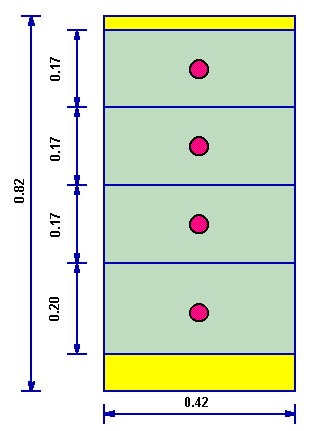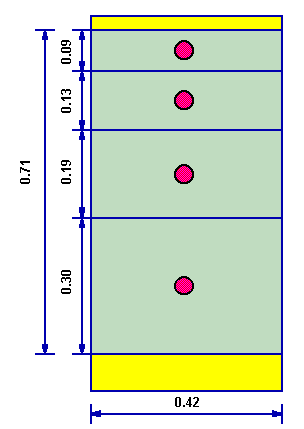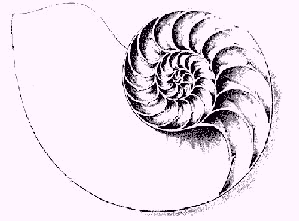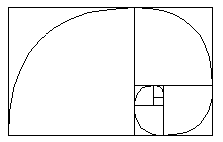Almost every day of our life we get into an object, of common use, that manages to charm us for its proportions, that appear to us of great, natural elegance. Sometimes we realize the object is actually the creation of some famous designer, and than we think that it is obvious, after all, that it looks so good to us. But some other times the object is something old, made well before modern industry, mostly for manufacturing reasons, had fed us with tons of new forms, materials and colors. It is when we become truly amazed, and we ask ourselves: "How did they do?" Other times it is a natural object (a cypress, a shell) that makes our amazement even greater.
Well, we leave to the lovers of philosophy to determine why, while we try to understand how it happens. So that we might manage to make our furniture look more "beautiful".
We only need to know that the golden section of a segment is approximately equal to 0.618. But, I suggest you take a moment to read carefully again the little sentence above, since it actually tells us a lot about the secret of such number, and the harmony that it gives us when we unknowingly see it in the things around us. The ones of you that had an opportunity to see Rome, probably remember the facade of the Pantheon. And surely they would remember the sensation of peace and beauty the facade gave them, while enjoying a drink at the tables of the café on the other side of the square. Well, guess what, the facade is high 0.618 times its length.
The practice
How do we actually use this golden section? Let's use it for what it is, a ratio. When we design a new piece, first of all we need to decide its dimensions. Normally, some of them are defined by its use or by standards. For instance, in Italy most dishwashers are 85 cm high, 60 cm wide, and 57 cm deep. If you are designing a cabinet to be placed on the side of the dishwasher, you must use the same high and depth. But for the remaining dimensions you have some freedom. For the piece above, the width can be set as you please, but not wider than the space you have available between the dishwasher and the next object (a wall, another cabinet). For other dimensions, you might have almost complete freedom. If the cabinet is actually a chest of drawers, you can set the high of each drawer freely.
Let's develop this example further, and compare two easy styles. We design a four drawer chest for our kitchen. We could set the hight to 82 cm, and width 42 cm. while the depth is not important for this example (see figure). The total hight of the drawers is 71 cm.
 A factory would decide for sure to make the drawers exactly the same, making each drawer 71/4 = 17.75 cm (or a little less, to leave some clearance between drawers). In this way, a single set up of the tools will be needed, increasing the capacity of the plant.
A factory would decide for sure to make the drawers exactly the same, making each drawer 71/4 = 17.75 cm (or a little less, to leave some clearance between drawers). In this way, a single set up of the tools will be needed, increasing the capacity of the plant.
But you observe that, making the cabinet manually, you don't care too much about the set up time of your tools. So you think to a compromise, making the bottom drawer a little higher: 20+17+17+17 cm. This way, you have an easier time making the measurements.
Next step is to consider that, if each drawer would have different dimensions, would also be more useful. The lower, at the top, for the small kitchen tools of most frequent use. The higher at the bottom, for big vases or pans.
And here is where the golden section can help: to give you the hight of the drawers in an harmonious succession. Each drawer is high the golden section of the preceding one.
How to set the heights? If A is the hight of the lowest drawer, than the hight of the next drawer would be A/0.618, the third one (A/0.618)/0.618 = A/(0.6182), and the forth one A/(0.6183). The total hight, indicated proportionally the the hight of the lowest one, would than be:
The total hight, indicated proportionally the the hight of the lowest one, would than be:

If it must be equal to 71 cm, than the first drawer would be::
A = 71 / 9.473 = 7.5 cm
Similarly the other ones would be:
7,5 / 0.618 = 12.1 cm
7,5 / 0.6182 = 19.6 cm
7,5 / 0.6183 = 31.8 cm
Now, a drawer 7.5 cm high is really too shallow. Than we empirically adjust the succession of the heights to 9, 13, 19, 30 cm. The result can be seen in the figure on the right. Isn't it more functional? Doesn't it look more elegant?
The Bodoni, ancient family of printers and publishers, used to proportion the hight and width of their books to the golden section....
Version 1.0 - May 3, 1998
 A factory would decide for sure to make the drawers exactly the same, making each drawer 71/4 = 17.75 cm (or a little less, to leave some clearance between drawers). In this way, a single set up of the tools will be needed, increasing the capacity of the plant.
A factory would decide for sure to make the drawers exactly the same, making each drawer 71/4 = 17.75 cm (or a little less, to leave some clearance between drawers). In this way, a single set up of the tools will be needed, increasing the capacity of the plant.
 Although certain proportioning systems have reached over time high complexity, the basic principle is simple: in order for an object to be well proportioned, each one of its parts has to relate to the others. We positively react to objects built in such way (they look to us more "beautiful"), since they relate man made with the natural world. For instance, one of the oldest proportioning systems, i.e. the Golden Section, can be found in nature. The leaves of certain trees are separated along the branch by distances that are proportioned to the golden section. Or the internal spiral of certain sea shells can be completely contained in a set of rectangles which sides are proportioned as the golden section.
Although certain proportioning systems have reached over time high complexity, the basic principle is simple: in order for an object to be well proportioned, each one of its parts has to relate to the others. We positively react to objects built in such way (they look to us more "beautiful"), since they relate man made with the natural world. For instance, one of the oldest proportioning systems, i.e. the Golden Section, can be found in nature. The leaves of certain trees are separated along the branch by distances that are proportioned to the golden section. Or the internal spiral of certain sea shells can be completely contained in a set of rectangles which sides are proportioned as the golden section. Well, it was Euclid, a mathematician of ancient Greece, that defined such ratio with a mathematical formula. May be you had to study at school a simple phrase, probably just memorized back than without much though: the golden section is the part of the segment that is medium proportional between the whole segment and the remaining part. In Italy this topic is included in the math program of Junior High Schools, and I assume I learned it back then: but I do not have any recollection. It was my mother, a retired Junior High math teacher, who reminded me I should know it!
Anyway, for the lovers of math, I have provided a rigorous description in another page (see "The Golden Section"). We only need to know that the golden section of a segment is approximately equal to 0.618. But, I suggest you take a moment to read carefully again the little sentence above, since it actually tells us a lot about the secret of such number, and the harmony that it gives us when we unknowingly see it in the things around us. The ones of you that had an opportunity to see Rome, probably remember the facade of the Pantheon. And surely they would remember the sensation of peace and beauty the facade gave them, while enjoying a drink at the tables of the café on the other side of the square. Well, guess what, the facade is high 0.618 times its length.
Well, it was Euclid, a mathematician of ancient Greece, that defined such ratio with a mathematical formula. May be you had to study at school a simple phrase, probably just memorized back than without much though: the golden section is the part of the segment that is medium proportional between the whole segment and the remaining part. In Italy this topic is included in the math program of Junior High Schools, and I assume I learned it back then: but I do not have any recollection. It was my mother, a retired Junior High math teacher, who reminded me I should know it!
Anyway, for the lovers of math, I have provided a rigorous description in another page (see "The Golden Section"). We only need to know that the golden section of a segment is approximately equal to 0.618. But, I suggest you take a moment to read carefully again the little sentence above, since it actually tells us a lot about the secret of such number, and the harmony that it gives us when we unknowingly see it in the things around us. The ones of you that had an opportunity to see Rome, probably remember the facade of the Pantheon. And surely they would remember the sensation of peace and beauty the facade gave them, while enjoying a drink at the tables of the café on the other side of the square. Well, guess what, the facade is high 0.618 times its length.
 The total hight, indicated proportionally the the hight of the lowest one, would than be:
The total hight, indicated proportionally the the hight of the lowest one, would than be: